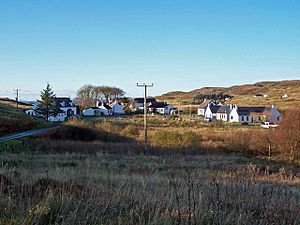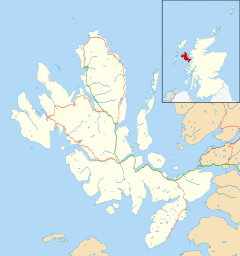Glendale, Skye facts for kids
Quick facts for kids Glendale
|
|
|---|---|
 Glendale |
|
| OS grid reference | NG175495 |
| Council area | |
| Country | Scotland |
| Sovereign state | United Kingdom |
| Postcode district | IV55 8 |
| Police | Northern |
| Fire | Highlands and Islands |
| Ambulance | Scottish |
| EU Parliament | Scotland |
Glendale (Scottish Gaelic: Gleann Dail) is a special place owned by the community. It is located on the north-west coast of the Duirinish peninsula. This area is part of the beautiful Isle of Skye in the Highland region of Scotland.
The Glendale estate includes many small farming villages called crofting townships. Some of these villages are Skinidin, Colbost, Fasach, Glasphein, Holmisdale, Lephin, Hamaraverin, Borrodale, Milovaig, Waterstein, Feriniquarrie, Totaig, and Hamara.
Contents
What's in a Name?
The name Glendale comes from two old Gaelic words. The first part, gleann, means "valley". This often describes a rougher area with steep or rocky sides. The second part, dail, means "field" or "meadow" near water. It usually refers to good, fertile land next to a river.
So, Glendale can mean "valley of river-meadows" or "valley of level fields by a river". Some people also think dail might come from the Norse word dalr, which also means "valley". If so, the name Glendale would simply mean "valley valley"!
The Land and Its Farms
The small farms in Glendale are spread out along a narrow valley. The soil here is very good for farming. This is because it is made of a special type of earth called oolitic loam.
The hills above the valley are made of basalt rock. This type of rock also helps the land. It provides good grazing areas for cattle and sheep.
A Fight for Land Rights
Glendale played a very important role in a big struggle for land rights. This happened in the late 1800s during a time called the Highland Clearances. During this period, many local farmers, known as crofters, were fighting for fairer land laws.
The Battle of the Braes and Its Spread
After a conflict called the Battle of the Braes in 1882, the unrest spread to Glendale. The landowners in Glendale made life very hard for the crofters. They would not let the local people collect wood from the shore for heating their homes. The crofters even had to use straw to thatch their roofs because they were forbidden from cutting rushes.
Land was also in very short supply. The farms had been divided into smaller and smaller pieces. This was done to make space for people who had been forced off better land elsewhere.
The Glendale Martyrs
The crofters of Glendale decided to take action. They were led by a man named John MacPherson. They demanded that their common grazing land, which had been taken from them, be returned. They started grazing their cattle on this land, even though they were told not to.
Police tried to stop them in January 1883, but it didn't work. Eventually, a government official came to Skye on a navy gunboat called HMS Jackal. He came to talk with the crofters. Five crofters, including John MacPherson, agreed to go to a special trial. They were sentenced to two months in jail. These brave crofters became known as the "Glendale martyrs". There is a memorial in the village to remember them.
Making a Change: The Crofters Act
Because of the actions of the Glendale crofters, a special group was set up. This group was called the Napier Commission. Their job was to investigate the crofters' complaints. This eventually led to a very important law called the Crofters Act of 1886. This law brought big changes and helped protect the rights of crofters.
Historian Neil Oliver said that what happened in Glendale was a huge part of the history of the Highlands. He said the events were extraordinary. It is wonderful for communities to remember and teach their own history.
In July 2010, many people who had moved away from Glendale came back for a special homecoming event. During this event, a local man named Iain MacPherson blew a horn. This was the same horn once used by his great-grandfather, John MacPherson, the leader of the crofters.


